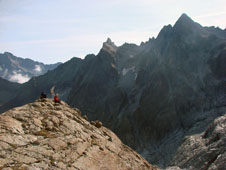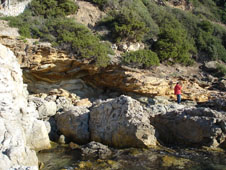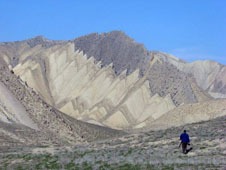Viti, C., Collettini, C., Tesei, T., Tarling, M. S., & Smith, S. A. F. (2018). Deforming processes, textural evolution and weakening in retrograde serpentinites. Minerals, 8, 241. doi: 10.3390/min8060241
Journal - Research Other
Rempe, M., Mitchell, T. M., Renner, J., Smith, S. A. F., Bistacchi, A., & Di Toro, G. (2018). The relationship between microfracture damage and the physical properties of fault-related rocks: The Gole Larghe Fault Zone, Italian Southern Alps. Journal of Geophysical Research: Solid Earth, 123(9), 7661-7687. doi: 10.1029/2018JB015900
Journal - Research Article
Tarling, M. S., Rooney, J. S., Viti, C., Smith, S. A. F., & Gordon, K. C. (2018). Distinguishing the Raman spectrum of polygonal serpentine. Journal of Raman Spectroscopy, 49, 1978-1984. doi: 10.1002/jrs.5475
Journal - Research Article
Negrini, M., Smith, S. A. F., Scott, J. M., & Tarling, M. S. (2018). Microstructural and rheological evolution of calcite mylonites during shear zone thinning: Constraints from the Mount Irene shear zone, Fiordland, New Zealand. Journal of Structural Geology, 106, 86-102. doi: 10.1016/j.jsg.2017.11.013
Journal - Research Article
Williams, J. N., Toy, V. G., Massiot, C., McNamara, D. D., Smith, S. A. F., & Mills, S. (2018). Controls on fault zone structure and brittle fracturing in the foliated hanging wall of the Alpine Fault. Solid Earth, 9, 469-489. doi: 10.5194/se-9-469-2018
Journal - Research Article
Rooney, J. S., Tarling, M. S., Smith, S. A. F., & Gordon, K. C. (2018). Submicron Raman spectroscopy mapping of serpentinite fault rocks. Journal of Raman Spectroscopy, 49(2), 279-286. doi: 10.1002/jrs.5277
Journal - Research Article
Smith, S. A. F., Tesei, T., Scott, J. M., & Collettini, C. (2017). Reactivation of normal faults as high-angle reverse faults due to low frictional strength: Experimental data from the Moonlight Fault Zone, New Zealand. Journal of Structural Geology, 105, 34-43. doi: 10.1016/j.jsg.2017.10.009
Journal - Research Article
Williams, J. N., Toy, V. G., Smith, S. A. F., & Boulton, C. (2017). Fracturing, fluid-rock interaction and mineralisation during the seismic cycle along the Alpine Fault. Journal of Structural Geology, 103, 151-166. doi: 10.1016/j.jsg.2017.09.011
Journal - Research Article
Smith, S. A. F., Griffiths, J. R., Fondriest, M., & Di Toro, G. (2017). “Coseismic foliations” in gouge and cataclasite: Experimental observations and consequences
for interpreting the fault rock record. In M. Y. Thomas, T. M. Mitchell & H. S. Bhat (Eds.), Fault zone dynamic processes: Evolution of fault properties during seismic rupture. (pp. 81-102). Hoboken, NJ: Wiley. doi: 10.1002/9781119156895.ch5
Chapter in Book - Research
Rempe, M., Smith, S., Mitchell, T., Hirose, T., & Di Toro, G. (2017). The effect of water on strain localization in calcite fault gouge sheared at seismic slip rates. Journal of Structural Geology, 97, 104-117. doi: 10.1016/j.jsg.2017.02.007
Journal - Research Article
Alder, S., Smith, S. A. F., & Scott, J. M. (2016). Fault-zone structure and weakening processes in basin-scale reverse faults: The Moonlight Fault Zone, South Island, New Zealand. Journal of Structural Geology, 91, 177-194. doi: 10.1016/j.jsg.2016.09.001
Journal - Research Article
Nielson, S., Spagnuolo, E., Violay, M., Smith, S., Di Toro, G., & Bistacchi, A. (2016). G: Fracture energy, friction and dissipation in earthquakes. Journal of Seismology, 20(4), 1187-1205. doi: 10.1007/s10950-016-9560-1
Journal - Research Article
Nielsen, S., Spagnuolo, E., Smith, S. A. F., Violay, M., Di Toro, G., & Bistacchi, A. (2016). Scaling in natural and laboratory earthquakes. Geophysical Research Letters, 43, 1504-1510. doi: 10.1002/2015GL067490
Journal - Research Article
Smith, S. A. F., Nielsen, S., & Di Toro, G. (2015). Strain localization and the onset of dynamic weakening in calcite fault gouge. Earth & Planetary Science Letters, 413, 25-36. doi: 10.1016/j.epsl.2014.12.043
Journal - Research Article
Fondriest, M., Aretusini, S., Di Toro, G., & Smith, S. A. F. (2015). Fracturing and rock pulverization along an exhumed seismogenic fault zone in dolostones: The Foiana Fault Zone (Southern Alps, Italy). Tectonophysics, 654, 56-74. doi: 10.1016/j.tecto.2015.04.015
Journal - Research Article
Remitti, F., Smith, S. A. F., Mittempergher, S., Gaultieri, A. F., & Di Toro, G. (2015). Frictional properties of fault zone gouges from the J-FAST drilling project (Mw 9.0 2011 Tohoku-Oki earthquake). Geophysical Research Letters, 42, 2691-2699. doi: 10.1002/2015GL063507
Journal - Research Article
Mitchell, T. M., Smith, S. A. F., Anders, M. H., Di Toro, G., Nielsen, S., Cavallo, A., & Beard, A. D. (2015). Catastrophic emplacement of giant landslides aided by thermal decomposition: Heart Mountain, Wyoming. Earth & Planetary Science Letters, 411, 199-207. doi: 10.1016/j.epsl.2014.10.051
Journal - Research Article
Kuo, L.-W., Li, H., Smith, S. A. F., Di Toro, G., Suppe, J., Song, S.-R., … Si, J. (2014). Gouge graphitization and dynamic fault weakening during the 2008 Mw 7.9 Wenchuan earthquake. Geology, 42(1), 47-50. doi: 10.1130/G34862.1
Journal - Research Article
Rempe, M., Smith, S. A. F., Ferri, F., Mitchell, T. M., & Di Toro, G. (2014). Clast-cortex aggregates in experimental and natural calcite-bearing fault zones. Journal of Structural Geology, 68(Part A), 142-157. doi: 10.1016/j.jsg.2014.09.007
Journal - Research Article
Fondriest, M., Smith, S. A. F., Candela, T., Nielsen, S. B., Mair, K., & Di Toro, G. (2013). Mirror-like faults and power dissipation during earthquakes. Geology, 41(11), 1175-1178. doi: 10.1130/G34641.1
Journal - Research Article
Smith, S. A. F., Di Toro, G., Kim, S., Ree, J.-H., Nielsen, S., Billi, A., & Spiess, R. (2013). Coseismic recrystallization during shallow earthquake slip. Geology, 41(1), 63-66. doi: 10.1130/G33588.1
Journal - Research Article
Smith, S. A. F., Bistacchi, A., Mitchell, T. M., Mittempergher, S., & Di Toro, G. (2013). The structure of an exhumed intraplate seismogenic fault in crystalline basement. Tectonophysics, 599, 29-44. doi: 10.1016/j.tecto.2013.03.031
Journal - Research Article
Fondriest, M., Smith, S. A. F., Di Toro, G., Zampieri, D., & Mittempergher, S. (2012). Fault zone structure and seismic slip localization in dolostones, an example from the Southern Alps, Italy. Journal of Structural Geology, 45, 52-67. doi: 10.1016/j.jsg.2012.06.014
Journal - Research Article
Smith, S. A. F., Agosta, F., Toussaint, R., & Holdsworth, R. E. (2012). Foreword to Special Issue: "Fault Zone Structure, Mechanics and Evolution in Nature and Experiment". Journal of Structural Geology, 45, 1-2. doi: 10.1016/j.jsg.2012.11.001
Journal - Research Other
Niemeijer, A., Di Toro, G., Ashley Griffith, W., Bistacchi, A., Smith, S. A. F., & Nielsen, S. (2012). Inferring earthquake physics and chemistry using an integrated field and laboratory approach. Journal of Structural Geology, 39, 2-36. doi: 10.1016/j.jsg.2012.02.018
Journal - Research Article
Smith, S. A. F., Billi, A., Di Toro, G., & Spiess, R. (2011). Principal slip zones in limestone: Microstructural characterization and implications for the seismic cycle (Tre Monti Fault, Central Apennines, Italy). Pure & Applied Geophysics, 168(12), 2365-2393. doi: 10.1007/s00024-011-0267-5
Journal - Research Article
Mittempergher, S., Di Toro, G., Gratier, J. P., Hadizadeh, J., Smith, S. A. F., & Spiess, R. (2011). Evidence of transient increases of fluid pressure in SAFOD phase III cores. Geophysical Research Letters, 38(3). doi: 10.1029/2010GL046129
Journal - Research Article
Bistacchi, A., Ashley Griffith, W., Smith, S. A. F., Di Toro, G., Jones, R., & Nielsen, S. (2011). Fault roughness at seismogenic depths from LIDAR and photogrammetric analysis. Pure & Applied Geophysics, 168(12), 2345-2363. doi: 10.1007/s00024-011-0301-7
Journal - Research Article
Collettini, C., Niemeijer, A., Viti, C., Smith, S. A. F., & Marone, C. (2011). Fault structure, frictional properties and mixed-mode fault slip behavior. Earth & Planetary Science Letters, 311(3-4), 316-327. doi: 10.1016/j.epsl.2011.09.020
Journal - Research Article
Smith, S. A. F., Holdsworth, R. E., & Collettini, C. (2011). Interactions between low-angle normal faults and plutonism in the upper crust: Insights from the Island of Elba, Italy. Geological Society of America Bulletin, 123(1-2), 329-346. doi: 10.1130/B30200.1
Journal - Research Article
Pearce, M. A., Jones, R. R., Smith, S. A. F., & McCaffrey, K. J. W. (2011). Quantification of fold curvature and fracturing using terrestrial laser scanning. AAPG Bulletin, 95(5), 771-794. doi: 10.1306/11051010026
Journal - Research Article
Smith, S. A. F., Holdsworth, R. E., Collettini, C., & Pearce, M. A. (2011). The microstructural character and mechanical significance of fault rocks associated with a continental low-angle normal fault: The Zuccale Fault, Elba Island, Italy. Geological Society, London, Special Publications, 359, 97-113. doi: 10.1144/SP359.6
Journal - Research Article
Smith, S. A. F., & Faulkner, D. R. (2010). Laboratory measurements of the frictional properties of the Zuccale low-angle normal fault, Elba Island, Italy. Journal of Geophysical Research, 115, B02407. doi: 10.1029/2008JB006274
Journal - Research Article
Di Toro, G., Niemeijer, A., Tripoli, A., Nielsen, S., Di Felice, F., Scarlato, P., … Smith, S. A. F., … Mariano, S. (2010). From field geology to earthquake simulation: A new state-of-the-art tool to investigate rock friction during the seismic cycle (SHIVA). Rendiconti Lincei, 21(Suppl. 1), (pp. 95-114). doi: 10.1007/s12210-010-0097-x
Conference Contribution - Published proceedings: Full paper
Ashley Griffith, W., Nielsen, S., Di Toro, G., & Smith, S. A. F. (2010). Rough faults, distributed weakening, and off-fault deformation. Journal of Geophysical Research, 115(8), B08409. doi: 10.1029/2009JB006925
Journal - Research Article
Collettini, C., Viti, C., Smith, S. A. F., & Holdsworth, R. E. (2009). Development of interconnected talc networks and weakening of continental low-angle normal faults. Geology, 37(6), 567-570. doi: 10.1130/G25645A.1
Journal - Research Article
Collettini, C., Holdsworth, R. E., & Smith, S. A. F. (2009). Fault zone structure and deformation processes along an exhumed low-angle normal fault: Implications for seismic behavior. In E. Fukuyama (Ed.), Fault-Zone Properties and Earthquake Rupture Dynamics. (pp. 69-85). Burlington, MA: Elsevier. doi: 10.1016/S0074-6142(08)00004-1
Chapter in Book - Research
Smith, S. A. F., Collettini, C., & Holdsworth, R. E. (2008). Recognizing the seismic cycle along ancient faults: CO2-induced fluidization of breccias in the footwall of a sealing low-angle normal fault. Journal of Structural Geology, 30(8), 1034-1046. doi: 10.1016/j.jsg.2008.04.010
Journal - Research Article
Collettini, C., Cardellini, C., Chiodini, G., De Paola, N., Holdsworth, R. E., & Smith, S. A. F. (2008). Fault weakening due to CO2 degassing in the Northern Apennines: Short- and long-term processes. Geological Society, London, Special Publications, 299, 175-194. doi: 10.1144/SP299.11
Journal - Research Article
Jones, R. R., McCaffrey, K. J. W., Imber, J., Wightman, R., Smith, S. A. F., Holdsworth, R. E., … Wilson, R. W. (2008). Calibration and validation of reservoir models: The importance of high resolution, quantitative outcrop analogues. Geological Society, London, Special Publications, 309, 87-98. doi: 10.1144/SP309.7
Journal - Research Article
Chattopadhyay, A., Khasdeo, L., Holdsworth, R. E., & Smith, S. A. F. (2008). Fault reactivation and pseudotachylite generation in the semi-brittle and brittle regimes: Examples from the Gavilgarh-Tan Shear Zone, central India. Geological Magazine, 145(6), 766-777. doi: 10.1017/S0016756808005074
Journal - Research Article
Imber, J., Holdsworth, R. E., Smith, S. A. F., Jefferies, S. P., & Collettini, C. (2008). Frictional-viscous flow, seismicity and the geology of weak faults: A review and future directions. Geological Society, London, Special Publications, 299, 151-173. doi: 10.1144/SP299.10
Journal - Research Article
Watts, L. M., Holdsworth, R. E., Sleight, J. A., Strachan, R. A., & Smith, S. A. F. (2007). The movement history and fault rock evolution of a reactivated crustal-scale strike-slip fault: The Walls Boundary Fault Zone, Shetland. Journal of the Geological Society, 164(5), 1037-1058. doi: 10.1144/0016-76492006-156
Journal - Research Article
Smith, S. A. F., Holdsworth, R. E., Collettini, C., & Imber, J. (2007). Using footwall structures to constrain the evolution of low-angle normal faults. Journal of the Geological Society, 164(6), 1187-1191. doi: 10.1144/0016-76492007-009
Journal - Research Article
Smith, S. A. F., Strachan, R. A., & Holdsworth, R. E. (2007). Microstructural evolution within a partitioned midcrustal transpression zone, northeast Greenland Caledonides. Tectonics, 26(4), TC4003. doi: 10.1029/2006TC001952
Journal - Research Article
Pearce, M. A., Jones, R. R., Smith, S. A. F., McCaffrey, K. J. W., & Clegg, P. (2006). Numerical analysis of fold curvature using data acquired by high-precision GPS. Journal of Structural Geology, 28(9), 1640-1646. doi: 10.1016/j.jsg.2006.05.010
Journal - Research Article
 MSci PhD (Durham)
MSci PhD (Durham) 1. Surveying the Gole Larghe Fault Zone in the Upper Genova Valley, Adamello, Italian Alps, using a terrestrial laser scanner.
1. Surveying the Gole Larghe Fault Zone in the Upper Genova Valley, Adamello, Italian Alps, using a terrestrial laser scanner.  2. Exposures of the Zuccale low-angle normal fault on the Island of Elba, Italy.
2. Exposures of the Zuccale low-angle normal fault on the Island of Elba, Italy.  3. Tilted (sub-vertical) sedimentary sequences exposed in the deserts of Azerbaijan. Heavy erosion has formed gullies creating v-shaped outcrop patterns.
3. Tilted (sub-vertical) sedimentary sequences exposed in the deserts of Azerbaijan. Heavy erosion has formed gullies creating v-shaped outcrop patterns.